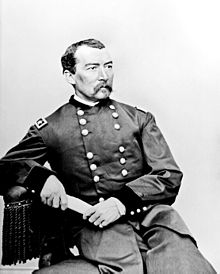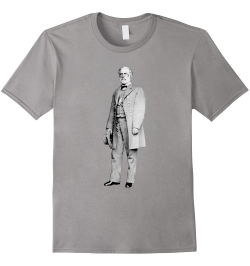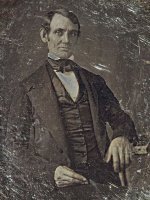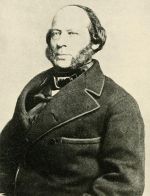This is a section of the book Tallmans In The Civil War. This page covers William Henry Tallman, you can read on, or click here to browse the rest of the book.
William Henry Tallman
The son of William Tripp Tallman born in Cayuga, NY moved as a child to Michigan with his parents. He enlisted into Company “K” of the Michigan 2nd Calvary as Corporal on September 26, 1861 at Port Huron for 3 years. He was 23 years old. The Company was mustered on Oct. 2nd, 1861. Rising through the ranks quickly (possibly from his action at Boonville) he was promoted to Sergeant Major on July 26, 1862. On January 5th 1864, he re-enlisted at Mossy Creek, Tennessee and received a commission to Second Lieutenant (possibly a result at the Battle of Dandridge.) Transferred to Company “D” on 1 March, 1864 and mustered March 30th. Commissioned to Captain on October 7th of 1864, his muster didn't take place until March 14, 1865. To rise to a permanent Military rank he was discharged and accepted an appointment as Captain of the 136th US Colored Troops on July 14, 1865
The regiment left Grand Rapids Nov. 14, 1861 for St. Louis and its service during the war in the western front. The Second was under the command of Capt. Gordon Granger who had been commissioned Colonel Sept. 2nd and would rise to Major General by war’s end. The Second was assigned to the army under General Pope, then operating against Island No. Ten near New Madrid, Missouri and saw its first real action here. After its capture they took part in the siege of Corinth engaged in scouting and skirmishing. When Colonel Granger was appointed a Brigadier, Michigan Governor Blair appointed Captain Philip H. Sheridan to its command and commissioned him Colonel on May 25, 1862.
Under Sheridan (right) they participated in the spirited action at Boonville, Miss on July 1, 1862 one of the most brilliant minor engagements of the war. The bulk of the Union force stayed on the defensive while Sheridan sent the 2nd Michigan Cavalry under Capt. Russell Alexander and the 2nd Iowa Cavalry under Lt. Col. Edward Hatch to attack the Confederate rear and left flank, respectively. The cavalry forces pushed Chalmers to retreat and Sheridan called off the pursuit after four miles, when his fatigued troop’s encountered swampy terrain. It was this engagement that brought Sheridan’s promotion to Brigadier General.
Colonel A. P. Campbell was commissioned July I, 1862, to fill the vacancy caused by the promotion of Sheridan. The Second was a part of General Buell's army when the move was made upon Perryville, Ky., in Oct., 1862, and achieved an enviable reputation in its stubborn fight with the enemy, driving him in confusion from the field.
In December 1862 and January 1863, the Second was in East Tennessee doing an immense amount of damage to the enemy's railroads and meeting the confederates in the field on numerous occasions. The following month the regiment returned to Nashville and had several severe skirmishes with the confederates under Forest and Vandorn.
On May 5th, it participated in the severe engagement of Thompson's Station, Tenn., where; with the balance of the Union troops, it was driven from the field by superior numbers and only escaped capture by the most heroic efforts.
During the next six months the regiment was constantly on the move, scouting and skirmishing with the enemy, and frequently had sharp encounters, with Forest's Cavalry.
In September, the Second was engaged the 18th, 19th and 20th at Chickamauga and performed the most valuable service in holding the enemy's advance and scouting the country, giving important information to the Union Commanders. After Chickamauga, the Second pursued General Wheeler, who was making a raid on our communications in the rear of the army, and did excellent service in thwarting the designs of the confederate General. Again in November, the Second proceeded to East Tennessee and after a series of hard marches, met the enemy in a severe engagement at Dandridge on 17 January, 1864.
During the winter the Regiment was constantly in the saddle, marching long distances with inadequate supplies of rations and clothing. The hardships and suffering of the troops during the East Tennessee campaign had no parallel in the history of the war. The weather was cold, the snow often falling so as to cover the blankets of the men, who slept in the open air for want of tents. The only rations or forage issued was secured by the soldiers themselves. The clothing had become worn by long use and did not serve to protect the troops from the chilling rains and cutting winds. The horses were unfed and unshod and the general suffering of men and horses during the winter is one of painful contemplation. Even under these most disheartening and discouraging circumstances on the 29th of March, 1864, 326 members of the regiment re-enlisted for three years, or duration of the war and returned to Michigan on a veteran furlough for 30 days. On the 3rd of May, the regiment, except those on veteran furlough entered upon the Atlanta campaign with General Sherman's army. It saw active duty nearly every day as well as nights during this campaign until it reached Lost Mountain, when on the 29th of June, it was sent to Franklin, Tenn., and was there joined by the veterans who had returned from Michigan. It soon started after its old enemy General Wheeler, and was constantly in the saddle looking after the Confederate forces under General Forest. They came in contact with them several times, pursuing him until he retired too far south to follow. When Confederate General Hood marched north, the Second confronted his forces, retarded his march and destroyed many of his wagons, and captured his guns and baggage. Throughout the year, the Second patrolled through Tennessee, Alabama, Kentucky and Georgia, sustaining losses, but inflicting much greater upon the enemy.
No brief history can do justice to a cavalry regiment that frequently operates by itself in the enemy's country. One that’s far from its support or base of supplies and when the good judgment of its officers must determine whether to attack or retreat and when the responsibilities of the safety or destruction of the organization rests with the immediate officers in command. To write the history of a cavalry regiment requires far beyond the limits of casual mention and beyond an abridged article as in this case.
After the battle of Nashville the Second again started south, marching through Alabama and then turning east reached Macon, Ga., on May 1, 1865. The war having practically ended, the regiment was broken into companies to guard a number of towns and preserve order. The headquarters of the regiment remained at Macon until August 17, when it was mustered out of service and returned to Jackson, Mich. There it was paid and disbanded on August 26, 1865.
After the war William settled down in Hillsdale, he married Alice Spring in April of 1866. William would become the publisher of the Hillsdale Democrat for almost 20 years; when Alice died in early 1891. He then took a clerks position at the State House in Lansing serving in 1891-2. Returning to Hillsdale, he married Cora Sampson and helped run the Hillsdale Leader until the fall of 1908 when they moved to LaGrange, Indiana where he purchased the LaGrange Democrat. With his death on March 20, 1909 he leaves his wife Cora and two sons, three of his children preceded him. In Hillsdale he was prominent in the Grand Army and Masonic circles. The family is buried in Oak Grove Cemetery, Hillsdale, Mich.








New! Comments
Have your say about what you just read! Leave me a comment in the box below.